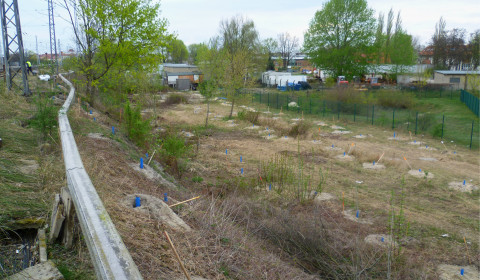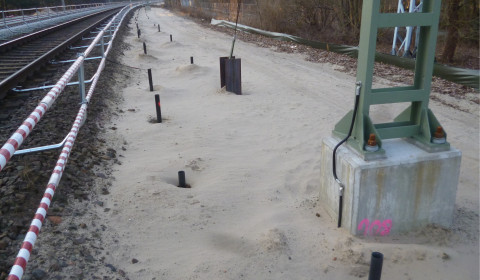UXO detection DB Oranienburg
Detection of Unexploded Ordnance along the train tracks and stations of Oranienburg, Nassenheide and Lehnitz using borehole radar
We have applied borehole radar technology since 2012 during large-scale projects of the Deutsche Bahn (DB) to detect unexploded ordnance along the railway tracks between and around the stations Lehnitz, Oranienburg, Sachsenhausen and Nassenheide (north of Berlin). Both the underground beneath active railway tracks and beneath surrounding areas had to be investigated and approved to be free of unexploded ordnance (mainly large caliber aerial bombs). The greatest challenge during the investigations was to protect and preserve the existing infrastructure covering most of the investigation area, especially the recently renovated station platforms, bridges and railway structures like switches, signalling installations, etc.
Thus borehole radar was applied in those areas where a dense borehole grid like it would have been necessary for borehole magnetics was unsuitable as it would have riddled infrastructure or otherwise difficult terrain (steep slopes).
Along the ca. 6 km long railway track between Lehnitz and Nassenheide and surrounding properties 58 subareas with a total of ca. 12 600 boreholes covering an area of 178 000 m² were investigated. Despite variable ground conditions and different resulting detection ranges achievable by the radar technology this translates to a mean area of 14 m² investigated per borehole.
During this project we cooperated closely with different demining expert teams including our long-standing partner Heinrich Hirdes Kampfmittelräumung GmbH as well as Schollenberger Kampfmittelbergung GmbH and Tauber DeDeComp GmbH. Our main tasks involved not only the planning of the boreholes with consideration of the documented railway infrastructure at the time of WWII and existing bridge and building foundations, but also the borehole radar measurements and complex analysis and interpretation of all the recorded data.
-

Boreholes for ground penetrating radar measurements along the railway tracks -

Radar measurements covered the ground beneath the tracks from boreholes beside the railway tracks -

Radar measurements were conducted in boreholes beside the tracks during ongoing railway traffic
